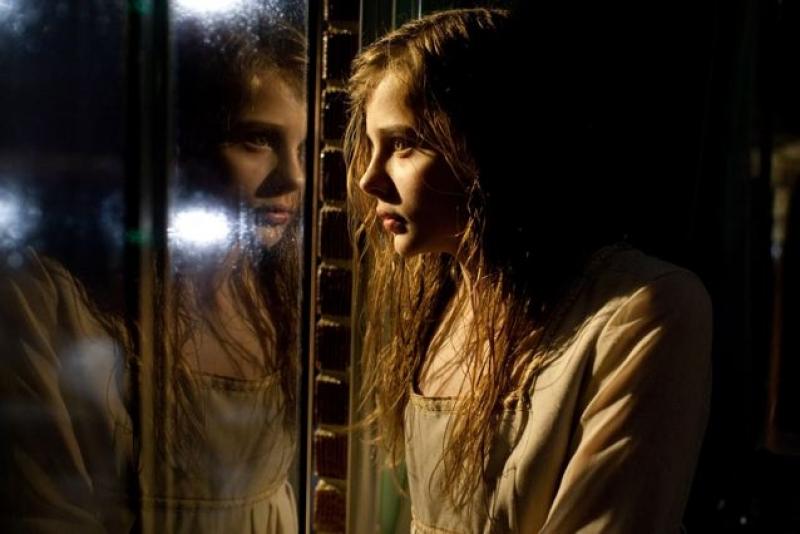Let Me In | reviews, news & interviews
Let Me In
Let Me In
Brilliant Swedish vampire movie gets middling English makeover

By the standards of contemporary horror movies, Let Me In has several things going for it. It isn't about somebody being tortured to death, its leading characters aren't played by the usual vapid twentysomething actors pretending to be high-school students, and, by and large, it eschews some of the more tedious horror fads of our time, such as herky-jerky editing, or big "Boo!" musical cues designed to make you jump.
But let us try to be fair, and assume you haven't seen and liked Tomas Alfredson's 2008 film, adapted by John Ajvide Lindqvist from his own novel Låt den rätte komma in, and have no intention of watching it in the near future. In which case, you may well find the remake quite satisfactory. The director and screenwriter is Matt Reeves, who has form in the horror genre; he was co-creator, with J J Abrams, of TV's Felicity, but made his feature-directing debut with Cloverfield, an effective shaky-cam monster-in-Manhattan movie.
 It's 1983 and there's snow on the ground. The dark, dark story has been transposed from suburban Stockholm to a housing estate in Los Alamos, New Mexico. That this location is, for many of us, synonymous with the atomic bomb is significant only in that, like the original setting of Blackeberg in Sweden, it originated as a planned community, in this case to provide housing for employees of The Manhattan Project. In other words, despite the sinister nuclear baggage, it's a place lacking in the cobwebbed history of the traditional Gothic yarn. I guess you could call it a social realist vampire film. If it were set in the UK (and since this is an Anglo-American production from the latest reincarnation of Hammer, it's rather a shame it isn't) they would probably have picked Milton Keynes.
It's 1983 and there's snow on the ground. The dark, dark story has been transposed from suburban Stockholm to a housing estate in Los Alamos, New Mexico. That this location is, for many of us, synonymous with the atomic bomb is significant only in that, like the original setting of Blackeberg in Sweden, it originated as a planned community, in this case to provide housing for employees of The Manhattan Project. In other words, despite the sinister nuclear baggage, it's a place lacking in the cobwebbed history of the traditional Gothic yarn. I guess you could call it a social realist vampire film. If it were set in the UK (and since this is an Anglo-American production from the latest reincarnation of Hammer, it's rather a shame it isn't) they would probably have picked Milton Keynes.
First, the good news. Kodi Smit-McPhee, miscast and annoyingly whiney in The Road, is fine as Owen, a lonely 12-year-old who spies on his neighbours through a telescope, and is just creepy enough for you to understand why he's bullied at school. Chloe Grace Moretz, who stole all her scenes as Hit-Girl in Kick-Ass, looks too coltishly long-legged for the role of Abby, the little girl who moves in next door with her "father", though perfectly conveys the weary innocence of a girl who describes herself as "12, more or less", but who has been around a lot longer than that.
 Predictably missing is the sexual ambiguity of the Swedish original, which made Eli's protestations of, "I'm not a girl" so double-edged. And when bloodlust causes Abby's face to morph, it's not into a centuries-old creature but into a bog-standard scary-movie monster, which is less troubling. Abby's "dad" is played by Richard Jenkins (probably best known as the father in Six Feet Under) who's presented as more of an ageing Platonic boyfriend than paedophile helpmate. His function is to provide Abby with fresh blood, and the tense scenes in which he stalks his victims are one of the few areas in which Reeves profitably leaves the original film behind and stakes out his own territory, making one wish he'd started from scratch from Lindqvist's novel instead of merely parroting his screenplay.
Predictably missing is the sexual ambiguity of the Swedish original, which made Eli's protestations of, "I'm not a girl" so double-edged. And when bloodlust causes Abby's face to morph, it's not into a centuries-old creature but into a bog-standard scary-movie monster, which is less troubling. Abby's "dad" is played by Richard Jenkins (probably best known as the father in Six Feet Under) who's presented as more of an ageing Platonic boyfriend than paedophile helpmate. His function is to provide Abby with fresh blood, and the tense scenes in which he stalks his victims are one of the few areas in which Reeves profitably leaves the original film behind and stakes out his own territory, making one wish he'd started from scratch from Lindqvist's novel instead of merely parroting his screenplay.
But Reeves also feels the need, several times, to spell out in pedantic detail what was left to viewers of the original to work out for themselves. "Maybe I'm getting sloppy," Jenkins says after botching his latest kill. "Maybe I want to get caught. Maybe I'm just tired of all this." Well duh, and maybe you're spoon-feeding us. The cat attack, least successful scene in the original due to some dodgy CGI, has been dropped, and while the remake concentrates on the relationship between the world-weary vampire and the boy (who, it's hinted, is only the latest in a long line of romantic partners), it lets most of the secondary characters go hang, relegating Abby's victims to anonymous cyphers, except for a dogged cop played by Elias Koteas, who takes over the vampire hunter role from the original's drunken avenger.
But what the original suggests with sparse, eloquent camera movements and elegant pulled focus, the remake tries to hammer home, disastrously, with music. Michael Giacchino's score is not bad in itself, but it's plastered all over the film, dictating our every mood and emotion, barely letting up for a moment. Oh look (ominous chord) here come the bullies and (delicate tinkly accompaniment) here we have heart-to-heart bonding and (tremulous strings) gosh, this bit is scary. It's like someone finishing all your sentences for you when you're speaking.
It's a shame, because otherwise, in remake terms, this is an honourable attempt which doesn't betray its source material and, aside from the aforementioned on-the-nose dialogue, actually requires viewers to use their imaginations. Alas, thanks mostly to the soundtrack, they might as well have retitled it Let the Bleeding Obvious One In.
- Anne Billson is the author of a forthcoming book about Let the Right One In, the film
Add comment
The future of Arts Journalism
You can stop theartsdesk.com closing!
We urgently need financing to survive. Our fundraising drive has thus far raised £49,000 but we need to reach £100,000 or we will be forced to close. Please contribute here: https://gofund.me/c3f6033d
And if you can forward this information to anyone who might assist, we’d be grateful.

Subscribe to theartsdesk.com
Thank you for continuing to read our work on theartsdesk.com. For unlimited access to every article in its entirety, including our archive of more than 15,000 pieces, we're asking for £5 per month or £40 per year. We feel it's a very good deal, and hope you do too.
To take a subscription now simply click here.
And if you're looking for that extra gift for a friend or family member, why not treat them to a theartsdesk.com gift subscription?
more Film
 Urchin review - superb homeless drama
Frank Dillane gives a star-making turn in Harris Dickinson’s impressive directorial debut
Urchin review - superb homeless drama
Frank Dillane gives a star-making turn in Harris Dickinson’s impressive directorial debut
 Mr Blake at Your Service review - John Malkovich in unlikely role as an English butler
Weird comedy directed by novelist Gilles Legardinier
Mr Blake at Your Service review - John Malkovich in unlikely role as an English butler
Weird comedy directed by novelist Gilles Legardinier
 Don't Let's Go to the Dogs Tonight review - vivid adaptation of a memoir about a Rhodesian childhood
Embeth Davidtz delivers an impressive directing debut and an exceptional child star
Don't Let's Go to the Dogs Tonight review - vivid adaptation of a memoir about a Rhodesian childhood
Embeth Davidtz delivers an impressive directing debut and an exceptional child star
 One Battle After Another review - Paul Thomas Anderson satirises America's culture wars
Leonardo DiCaprio, Teyana Taylor, and Sean Penn star in a rollercoasting political thriller
One Battle After Another review - Paul Thomas Anderson satirises America's culture wars
Leonardo DiCaprio, Teyana Taylor, and Sean Penn star in a rollercoasting political thriller
 Steve review - educator in crisis
Cillian Murphy excels as a troubled headmaster working with delinquent boys
Steve review - educator in crisis
Cillian Murphy excels as a troubled headmaster working with delinquent boys
 Can I get a Witness? review - time to die before you get old
Ann Marie Fleming directs Sandra Oh in dystopian fantasy that fails to ignite
Can I get a Witness? review - time to die before you get old
Ann Marie Fleming directs Sandra Oh in dystopian fantasy that fails to ignite
 Happyend review - the kids are never alright
In this futuristic blackboard jungle everything is a bit too manicured
Happyend review - the kids are never alright
In this futuristic blackboard jungle everything is a bit too manicured
 Robert Redford (1936-2025)
The star was more admired within the screen trade than by the critics
Robert Redford (1936-2025)
The star was more admired within the screen trade than by the critics
 Blu-ray: The Sons of Great Bear
DEFA's first 'Red Western': a revisionist take on colonial expansion
Blu-ray: The Sons of Great Bear
DEFA's first 'Red Western': a revisionist take on colonial expansion
 Spinal Tap II: The End Continues review - comedy rock band fails to revive past glories
Belated satirical sequel runs out of gas
Spinal Tap II: The End Continues review - comedy rock band fails to revive past glories
Belated satirical sequel runs out of gas

Comments
...
...
...
...